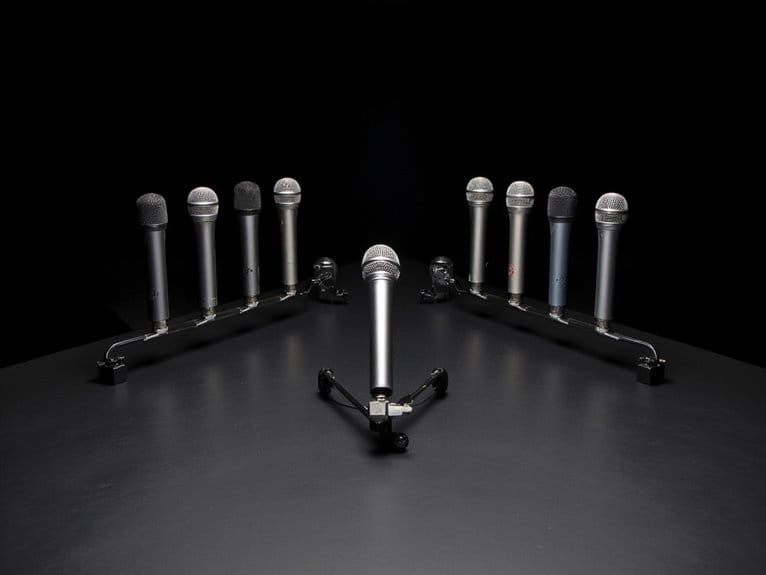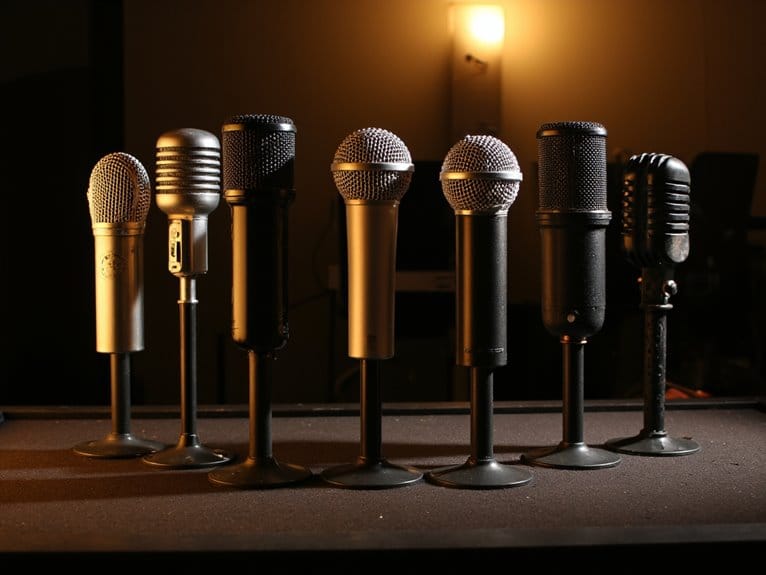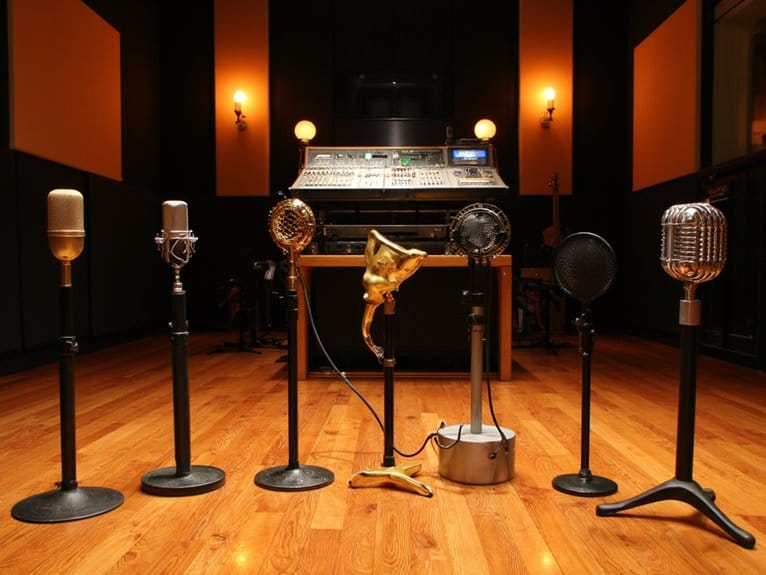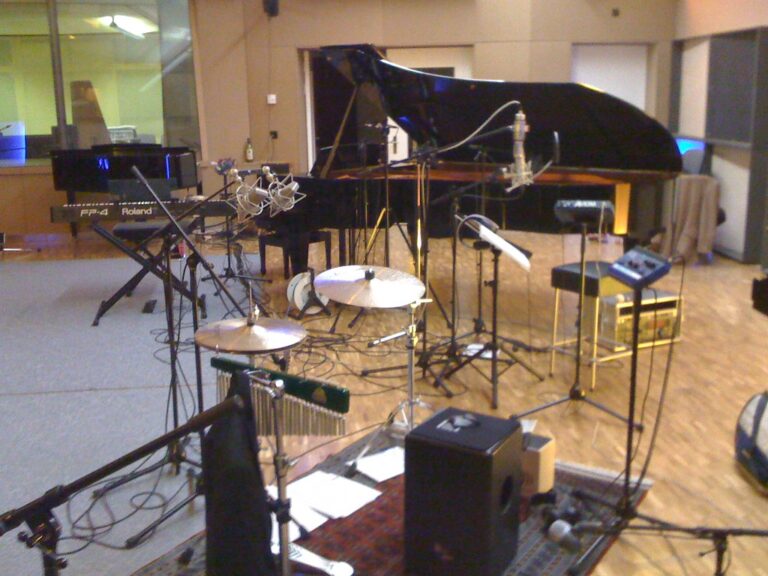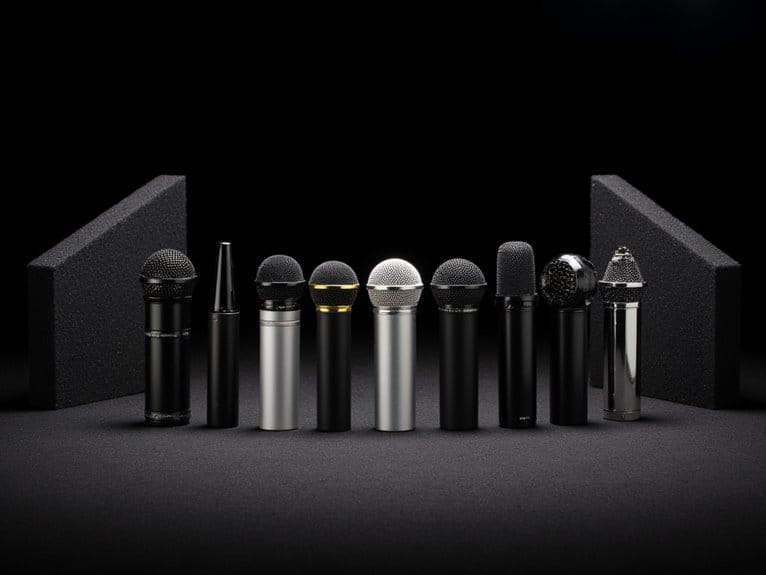Microphone Accessories: Pop Filters, Shock Mounts, and Windshields
Pop filters, shock mounts, and windshields are essential components for ensuring high-quality sound in recordings. Pop filters excel at reducing explosive sounds like ‘p,’ ‘b,’ and ‘t,’ whilst minimizing unwanted noise and enhancing vocal clarity for professional-grade results. Shock mounts, on the other hand, shield microphones from vibrations and handling noise, extending their longevity and protecting against physical disturbances. Windshields offer noise reduction benefits, ensuring clear audio by shielding against unwanted rumble and interference. Understanding the nuances of these accessories can greatly enhance your recording experience.
We are supported by our audience. When you purchase through links on our site, we may earn an affiliate commission, at no extra cost for you. Learn more.
Importance of Pop Filters
Pop filters play a critical role in enhancing audio quality by reducing plosive sounds like ‘p,’ ‘b,’ and ‘t’ during microphone recordings. These accessories are vital in minimizing unwanted noise and improving the clarity of vocals and speech. In studio settings, pop filters are essential to guarantee professional-grade recordings that are free from distortion caused by air blasts.
Pop filters are typically designed with acoustically transparent materials that allow the natural sound of the voice to pass through while preventing plosives from hitting the microphone diaphragm. They come in various types and designs, such as double-layered, split-level, or foam windscreens, catering to different recording needs and environments. Foam pop filters, for instance, are known for their effectiveness in reducing plosive sounds while being cost-effective and easy to maintain.
When recording vocals or speech, using a pop filter can greatly enhance the overall quality of the audio by preventing harsh bursts of air from distorting the sound. By strategically placing a pop filter between the microphone and the speaker, you can achieve cleaner recordings with improved intelligibility and reduced post-processing requirements. To sum up, pop filters are indispensable tools for anyone looking to achieve professional sound quality in their recordings.
Benefits of Shock Mounts
In professional audio recording environments, shock mounts play an important role in minimizing vibrations and handling noise to guarantee cleaner and higher-quality recordings. A shock mount is a critical accessory designed to isolate the microphone from physical disturbances and floor vibrations. By doing so, it greatly reduces unwanted noise that can compromise the clarity and precision of recorded audio.
The primary benefit of using a shock mount is the enhancement of audio quality. By isolating the microphone from vibrations and handling noise, shock mounts help capture sound with greater fidelity and accuracy. This results in recordings that are free from unwanted distortions and background noise, ensuring a professional and polished final product.
Furthermore, shock mounts not only improve the immediate audio output but also contribute to the longevity of your microphone. By protecting the microphone from physical shocks and vibrations, shock mounts help prevent damage that could affect its performance over time. This added protection can ultimately save you money by prolonging the lifespan of your equipment.
Advantages of Windshields
Windshields offer significant noise reduction benefits by shielding the microphone from unwanted rumble and interference, particularly essential for outdoor recording scenarios. They provide a barrier against wind noise and plosives, ensuring clear audio capture in studio environments. Using professional-grade windshields made from acoustically transparent materials enhances recording clarity and precision by minimizing distortion caused by wind interference.
Noise Reduction Benefits
Utilizing high-quality windshields is pivotal for achieving peak noise reduction and enhancing audio clarity in various recording settings. Windshields play a critical role in minimizing unwanted noise, such as wind interference and low-frequency rumble, ensuring a clean audio signal. By acting as a barrier between the microphone and external disturbances, windshields help maintain the integrity of recordings, especially in outdoor environments where environmental factors can impact sound quality. Professional-grade windshields are crafted from acoustically transparent materials, allowing sound to pass through unhindered while effectively blocking out disruptive elements. In studio setups, windshields are essential for eliminating plosive sounds, ensuring distortion-free recordings and delivering professional-grade audio quality.
Outdoor Recording Advantages
When recording outdoors, the use of professional-grade windshields becomes indispensable in ensuring high-quality audio by effectively blocking unwanted noise interference. The advantages of windshields in outdoor recording include:
- Wind Interference Protection: Windshields shield the microphone from gusts, preventing disruptive noise.
- Acoustically Transparent Design: Professional windshields are built with materials that allow sound to pass through clearly while blocking wind noise.
- Enhanced Audio Clarity: Windshields minimize distortion caused by wind interference, ensuring precise and clear recordings.
- Microphone Protection: Windshields safeguard the microphone from environmental elements, preserving its longevity and performance.
Choosing the Right Pop Filter
When choosing a pop filter, think about both the kind of filter and its position. The kind of pop filter you select, like foam or nylon, can greatly affect its performance in reducing plosive sounds. Additionally, proper placement of the pop filter in front of the microphone is essential for best effectiveness.
Pop Filter Types
To select the appropriate pop filter for your microphone, consider the specific type of pop filter that best suits your recording requirements and equipment compatibility. When choosing a pop filter, you will encounter various types that offer different levels of protection against plosive sounds. Here are some popular pop filter types to help you make an informed decision:
- Nylon Mesh Pop Filter: Effective at reducing plosive sounds while maintaining audio clarity.
- Metal Pop Shield: Durable and provides excellent protection against strong plosives.
- Foam Windscreen: Ideal for outdoor recording to minimize wind noise and light plosives.
- Double-Layered Pop Screen: Offers enhanced protection by combining multiple layers of material for superior sound filtering.
Pop Filter Placement
Placing a pop filter in front of the microphone serves to mitigate plosive sounds caused by air bursts during speech. To guarantee effective reduction of plosives, it is advisable to position the pop filter approximately 2-3 inches away from the mic. The optimal placement angle is at 45 degrees to the microphone, maximizing the filter’s ability to minimize plosive noises. Pop filters with adjustable gooseneck or flexible arms offer versatility in positioning to accommodate various microphone setups. Selecting the right pop filter size and type based on the microphone diameter is vital for a secure and snug fit, enhancing the filter’s effectiveness in reducing plosives. Additionally, incorporating a foam windscreen in conjunction with the pop filter can further improve the reduction of plosive sounds for clearer audio recordings.
Selecting the Ideal Shock Mount
Select the perfect shock mount by considering your microphone’s diameter for a secure and snug fit, ensuring ideal isolation from vibrations and handling noise. When selecting a shock mount, keep in mind the following key points:
- Microphone Compatibility: Confirm the shock mount is compatible with your microphone’s diameter. This will prevent any unnecessary movement or slippage during recordings, maintaining stability and isolation.
- Adjustable Screw Adapter: Opt for a shock mount that includes an adjustable screw adapter. This feature allows for versatility, accommodating various microphone models with different mounting options. It ensures a secure and customizable fit for your specific microphone.
- Material and Build Quality: Look for a shock mount constructed from durable materials such as high-quality plastics or metal. A well-built shock mount will provide effective vibration isolation, reducing unwanted noise and ensuring professional-grade audio recordings.
- Vibration Dampening Properties: Choose a shock mount that boasts excellent vibration dampening properties. This feature helps absorb shocks and vibrations, providing a steady and clear sound output by minimizing handling noise and external disturbances.
Picking the Perfect Windshield
When selecting a windshield for your microphone, prioritize choosing a model engineered with acoustically transparent materials for superior wind noise rejection. Professional-grade windshields are designed to minimize unwanted rumble and noise interference, making them essential for outdoor recordings. These windshields not only protect the microphone but also maintain audio quality by effectively reducing wind noise.
In addition to wind noise rejection, considering factors like microphone compatibility is essential when picking the perfect windshield. Make sure that the windshield fits securely over your specific microphone model to maximize its effectiveness. Compatibility issues can lead to gaps where wind noise may seep through, compromising the recording quality.
Moreover, selecting a windshield that complements a pop filter can further enhance the recording quality, especially in studio environments where plosives can be a concern. The combination of a windshield and pop filter provides thorough protection against various types of noise interference, ensuring clean and professional audio recordings.


